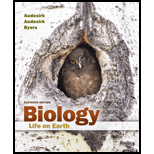
Concept explainers
The two groups of mammals with the largest number of species are
a. marsupials and monotremes.
b. carnivores and whales.
c. bats and rodents.
d. apes and lampreys.
Introduction:
Mammals are the part of Chordata taxonomic group as they possess distinctive characteristics like presence of notochord. Mammals are named due to the presence of mammary glands that secretes milk to feed newborns. There are numerous groups in the mammals based on specific characteristics, each containing numerous species of the mammals.
Answer to Problem 1MC
Correct answer:
The two groups of mammals with the largest number of species are bats and rodents.
Explanation of Solution
Explanation for the correct answer:
Option (c) is given that the two groups of mammals with the largest number of species are bats and rodents. Rodents constitute almost 40% of the mammal population while bats constitute around 20% of the mammal population. These two groups consist of 60% of the mammal population. Hence, option (c) is correct.
Explanation for incorrect answers:
Option (a) is given that the two groups of mammals with the largest number of species are marsupials and monotremes. There are only five species of monotremes in the world while only 330 species of marsupials. Most of the marsupials are situated in Australia. So, it is an incorrect option.
Option (b) is given that the two groups of mammals with the largest number of species are carnivores and whales. Carnivores belong to various groups and are not limited to the mammals. There are only 70% species of whales. Even with the large sizes, the actual numbers of these animals are small as compared to 60% population of bats and rodents. So, it is an incorrect option.
Option (d) is given that the two groups of mammals with the largest number of species are apes and lampreys. Apes are found in forests and most of the apes are endangered species. Their number is much less compared to a number of rodents and bats. Lampreys are a group of vertebrates. They do not belong to mammals. So, it is an incorrect option.
Hence, options, (a), (b), and (d) are incorrect.
Therefore, it can be concluded that the two groups of mammals with the largest number of species are bats and rodents.
Want to see more full solutions like this?
Chapter 25 Solutions
Biology: Life on Earth (11th Edition)
- drawing chemical structure of ATP. please draw in and label whats asked. Thank you.arrow_forwardOutline the negative feedback loop that allows us to maintain a healthy water concentration in our blood. You may use diagram if you wisharrow_forwardGive examples of fat soluble and non-fat soluble hormonesarrow_forward
- Just click view full document and register so you can see the whole document. how do i access this. following from the previous question; https://www.bartleby.com/questions-and-answers/hi-hi-with-this-unit-assessment-psy4406-tp4-report-assessment-material-case-stydu-ms-alecia-moore.-o/5e09906a-5101-4297-a8f7-49449b0bb5a7. on Google this image comes up and i have signed/ payed for the service and unable to access the full document. are you able to copy and past to this response. please see the screenshot from google page. unfortunality its not allowing me attch the image can you please show me the mathmetic calculation/ workout for the reult sectionarrow_forwardIn tabular form, differentiate between reversible and irreversible cell injury.arrow_forwardhelparrow_forward
- Can you please help me answer these questions?arrow_forwardSkryf n kortkuns van die Egyptians pyramids vertel ñ story. Maximum 500 woordearrow_forward1.)What cross will result in half homozygous dominant offspring and half heterozygous offspring? 2.) What cross will result in all heterozygous offspring?arrow_forward
- 1.Steroids like testosterone and estrogen are nonpolar and large (~18 carbons). Steroids diffuse through membranes without transporters. Compare and contrast the remaining substances and circle the three substances that can diffuse through a membrane the fastest, without a transporter. Put a square around the other substance that can also diffuse through a membrane (1000x slower but also without a transporter). Molecule Steroid H+ CO₂ Glucose (C6H12O6) H₂O Na+ N₂ Size (Small/Big) Big Nonpolar/Polar/ Nonpolar lonizedarrow_forwardwhat are the answer from the bookarrow_forwardwhat is lung cancer why plants removes liquid water intead water vapoursarrow_forward
 Concepts of BiologyBiologyISBN:9781938168116Author:Samantha Fowler, Rebecca Roush, James WisePublisher:OpenStax College
Concepts of BiologyBiologyISBN:9781938168116Author:Samantha Fowler, Rebecca Roush, James WisePublisher:OpenStax College Biology (MindTap Course List)BiologyISBN:9781337392938Author:Eldra Solomon, Charles Martin, Diana W. Martin, Linda R. BergPublisher:Cengage Learning
Biology (MindTap Course List)BiologyISBN:9781337392938Author:Eldra Solomon, Charles Martin, Diana W. Martin, Linda R. BergPublisher:Cengage Learning
 Biology: The Dynamic Science (MindTap Course List)BiologyISBN:9781305389892Author:Peter J. Russell, Paul E. Hertz, Beverly McMillanPublisher:Cengage Learning
Biology: The Dynamic Science (MindTap Course List)BiologyISBN:9781305389892Author:Peter J. Russell, Paul E. Hertz, Beverly McMillanPublisher:Cengage Learning





